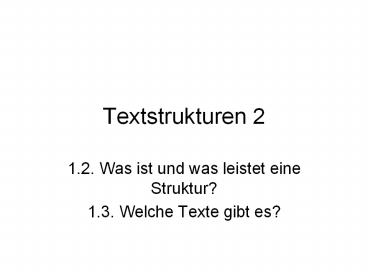Textstrukturen 2 - PowerPoint PPT Presentation
1 / 24
Title:
Textstrukturen 2
Description:
Each of the ordered units in a construction is a position. ... TK = Textkern. K = Kerninformation. A, B, C = beliebige Teilinformationen. Antragsstruktur ... – PowerPoint PPT presentation
Number of Views:7
Avg rating:3.0/5.0
Title: Textstrukturen 2
1
Textstrukturen 2
- 1.2. Was ist und was leistet eine Struktur?
- 1.3. Welche Texte gibt es?
2
(No Transcript)
3
29. Def. Each of the ordered units in a
construction is a position. Thus the English
construction of formative plus formative meaning
object in number has two positions and that of
free form plus free form plus free form meaning
actor acting on goal has three positions.
4
30. Assumption 10. Each position in a
construction can be filled only by certain
forms. Thus, in the English construction of
formative plus formative meaning object in
number the first position can be filled only by
certain formatives (noun-stems), and the second
only by certain other formatives (affixes of
number, such as the plural-sign -s). And in the
English construction of free form plus free form
plus free form meaning actor acting on goal the
first and third positions can be filled only by
certain free forms (object expressions) and the
second only by certain other free forms (finite
verb expressions). This assumption implies the
converse, namely, that a given form will appear
only in certain positions of certain
constructions. Thus, an English noun-stem will
appear only in the first position of the
construction object in number, in the second
position of the construction formative plus
formative meaning object having such an object
(long-nose), and in certain positions of a
certain few other constructions. Similarly, an
object expression, such as John, the man will
appear in the first position of the construction
actor acting on goal, or in the third, or in
certain positions of a certain few other
constructions.
5
31. Def. The meaning of a position is a
functional meaning. That is, the constructional
meaning of a construction may be divided into
parts, one for each position these parts are
functional meanings. It would be more concrete,
but perhaps less useful, if we said the meaning
common to all forms that can fill a given
position, when they are in that position, is a
functional meaning. Thus, in the English
construction of object in number the first
position has the functional meaning object, or,
more concretely, all the formatives (noun-stems)
which can occur in this position, have in common,
when they so appear, the functional meaning
object'. And in the English construction of
actor acting on goal' the first position has the
functional meaning actor', or, more concretely,
all the free forms (object-expressions, such as
nouns, noun-phrases, pronouns, etc.) which can
occur in this position, have in common, when they
so appear, the functional meaning actor. And in
this same construction, the third position has
the meaning goal, or, more concretely, all the
free forms (largely the same as those just
mentioned) which can appear in this position,
have in common, when they so appear, the meaning
goal. Leonard Bloomfield, A Set of Postulates
for the Science of Language, Language 2, 1926,
153-164, hier S. 157-160.
6
(No Transcript)
7
(No Transcript)
8
(No Transcript)
9
Nach Wolfgang Heinemann / Dieter Viehwe- ger,
Textlinguistik, Tübingen 1991
10
Elementare Funktionstypen
11
Gesamte Funktionstypen
12
Interaktionale Rahmentypen
13
Klassifizierung nach Partneranzahl
14
Klassifizierung nach sozialen Rollen
15
Lokale und temporale Merkmale
16
Klassifikation nach Entscheidungsprozessen
17
Antrag
18
Textstrukturierungstypen
TK Textkern K Kerninformation A, B, C
beliebige Teilinformationen
19
Antragsstruktur
20
Telegramm
21
Telegramm globales Textmuster
22
Todesanzeige
23
Diplomarbeit
24
Kochrezept































